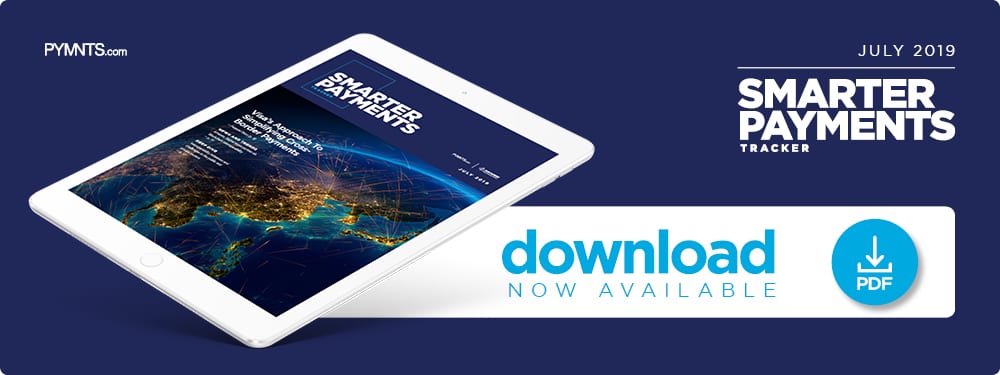
For merchants and FIs alike, cross-border payments can be a significant struggle. Compliance with governmental regulations, currency fluctuations and other factors can result in slow processing times, causing inconvenience for customers, says Vikram Modi, head of Visa Direct’s global platform and solutions. In this month’s Smarter Payments Tracker, PYMNTS spoke with Modi to discuss how the payments network is working to improve cross-border transactions by utilizing blockchain technology.
 Money is moving faster than ever, with innovations making it possible for consumers and businesses to send and receive payments within minutes as opposed to days. These innovations can save valuable time and money, but they do not often solve issues associated with international payments. Cross-border transactions remain difficult to navigate due to the various regulations and technologies available in different countries. The need to provide timely delivery exacerbates these challenges, as firms want to quickly conduct business with other companies and consumers want to provide financial support to family members.
Money is moving faster than ever, with innovations making it possible for consumers and businesses to send and receive payments within minutes as opposed to days. These innovations can save valuable time and money, but they do not often solve issues associated with international payments. Cross-border transactions remain difficult to navigate due to the various regulations and technologies available in different countries. The need to provide timely delivery exacerbates these challenges, as firms want to quickly conduct business with other companies and consumers want to provide financial support to family members.
Payments providers like Visa are focusing on solutions that increase speed and security for companies and individuals moving money between countries, while still offering seamless user experiences.
“I liken cross-border payments to a multidimensional Rubik’s Cube,” said Vikram Modi, vice president and head of Visa Direct Global Platform at Visa. “You have to make sure the colors match up across a myriad combinations of markets, currencies and use-cases. Cross-border payments have to be simple and fast for the users and seamless for the institutions involved, without the sender or receiver realizing the depth of complexities at play.”
Modi recently spoke with PYMNTS about the existing challenges involved in conducting cross-border transactions and how Visa is developing new solutions to ensure speed, efficiency and security.
Agility is key to navigating the cross-border ecosystem
One of the largest cross-border payments struggles is the interlocking puzzle that exists between different countries and local governments. Nearly every country has its own set of protocols in place to protect its citizens, and navigating those regulations is necessary for any provider looking to improve cross-border payment options.
Brazil requires tax IDs to accompany all payments made, for example, while many intra-European transactions are treated as quasi-domestic transfers with their own sets of rules. A transfer from Kansas to Africa could route through multiple different banks, each on its own network, before reaching the recipient’s account. Such transactions can keep small businesses waiting for payments or prevent family members from paying for emergency services.
FIs must stay on top of all necessary regulations in both the sending and receiving countries, as well each routing banks’ policies, if they want to increase payment speed and efficiency. Knowing country-specific requirements can significantly trim the timeline and ensure smooth transactions, and that’s where players like Visa fill the service gap.
“[Visa] bridges the information that is coming in from the send market into what is required in the receipt market,” Modi noted. “For example, if, in a particular market, different transaction limits apply for consumer vs. business remittances, or for domestic vs. cross-border transactions, we can provide these custom controls. We don’t have a one-size-fits-all approach — instead we build a lot of flexibility built into Visa Direct, while at the same time providing our partners complete visibility into what the transaction journey will look like.”
Ensuring Compliance While Improving Speed and Convenience
Ensuring that cross-border payments are both compliant and secure requires extensive resources. Providers must balance compliance with the need for seamless customer experiences, which is no simple task.
Some payments providers are leveraging blockchain and distributed ledger technology (DLT) to meet these needs, dramatically expediting the cross-border payment process. Visa does this with Visa B2B Connect, a cross-border payments platform built using elements of DLT and Linux Foundation’s Hyperledger Fabric network. The offering processes payments directly with Visa’s partners in a single day, rather than routing them through out-of-network FIs. Businesses can also use the solution to closely monitor each step of the process and pinpoint any issues that arise.
Mastercard tackled this problem by purchasing cross-border transaction providers to expand and enhance its payments networks, while Canadian payments network Interac invested in blockchain and DLT solutions similar to Visa’s.
The future of cross-border payments has arrived
Recent developments in artificial intelligence (AI) and machine learning (ML) have made these solutions possible without causing significant slowdowns. Rather than relying on painstaking human analysis, AI allows firms to process thousands of transactions per day, resulting in faster, stronger networks that leave seamless customer experiences intact.
“One of our main goals when it comes to providing additional ease and speed for both the users and the institutions that use Visa Direct for cross-border payments is to ensure they are not dealing with the complexities in the payment process behind the scenes,” said Modi. “Backed by the security and scale of Visa, and through our partnerships with leaders in the cross-border payments space including Western Union, Remitly and MoneyGram, we are working to create more efficient cross-border remittances for everyone across the globe.”
Maintaining a commitment to innovation is key to expediting cross-border payments. While improving the way businesses and people move money may not be a simple undertaking, it has the power to enhance lives in profound ways by ensuring true financial support and interconnectedness.